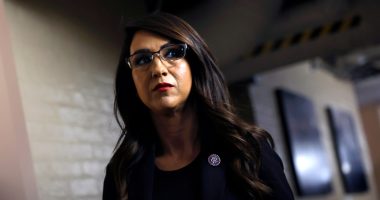
The closely watched music copyright trial involving Ed Sheeran, who was accused of copying his Grammy-winning ballad “Thinking Out Loud” from Marvin Gaye’s soul classic “Let’s Get It On,” continued Wednesday in federal court in Manhattan.
Mr. Sheeran testified Tuesday that he and a collaborator had written “Thinking Out Loud” based on their own experiences. The trial was briefly interrupted on Wednesday afternoon when the plaintiff, Kathryn Griffin Townsend, whose father, Ed Townsend, co-wrote “Let’s Get It On,” appeared to collapse and was carried out of the courtroom.
The music industry is keenly interested in the outcome of the case. Over the last decade, the business has been rocked by a series of infringement suits that have involved questions of just how much or how little of the work of pop songwriters can be protected by copyright, and how vulnerable they are to legal challenges.
The trend began in 2015 when a jury found that Robin Thicke and Pharrell Williams, in their hit “Blurred Lines,” had infringed on the copyright of another Gaye tune, “Got to Give It Up,” and they were ordered to pay more than $5 million in damages. The case shocked many legal experts — and musicians — who believed that Mr. Thicke and Mr. Williams were being penalized for using basic musical building blocks, like harmonies and rhythmic patterns, that had long been considered part of the public domain.
In 2020, an appeals court decision affirming Led Zeppelin’s victory over a copyright challenge to its song “Stairway to Heaven” seemed to steer case law back to more familiar territory. But plaintiffs are free to seek relief if they feel their rights have been infringed, and jury trials over music copyright can be especially unpredictable.
Here is a guide to what to know about the trial.
What do the songs sound like?
The lawsuit against Mr. Sheeran involves only the underlying musical composition of the two songs — their melodies, chords and lyrics — and not the specific recordings.
Listen to Ed Sheeran’s “Thinking Out Loud.”
Listen to Marvin Gaye’s “Let’s Get It On.”
Who are the plaintiffs?
While the “Blurred Lines” suit was filed by Gaye’s family, the plaintiffs in this case are heirs of Mr. Townsend, a songwriter and producer who collaborated with Gaye on his album “Let’s Get It On,” and who shares writing credit with Gaye on the title track. (Townsend, who died in 2003, was the primary songwriter of “Let’s Get It On,” earning two-thirds of the royalties from it.)
The case was filed in 2017 by Townsend’s daughter, Ms. Townsend; his sister, Helen McDonald; and the estate of his former wife, Cherrigale Townsend.
What was said in opening arguments?
In opening statements, Ben Crump, a lawyer for the plaintiffs, urged the jury to use “common sense” in comparing the two songs, and said that the evidence in the case included what he described as “a smoking gun”: a fan video from a concert which showed Mr. Sheeran performing a “mash-up,” or medley, in which he moved seamlessly between performing “Thinking Out Loud” and “Let’s Get It On,” and back again.
“That concert video is a confession,” said Mr. Crump, who is best known as a civil rights lawyer who represented the family of George Floyd.
Ilene S. Farkas, a lawyer for Sheeran, said in her opening statement that the concert video does not prove copyright infringement, and that onstage Mr. Sheeran frequently moves smoothly between his songs and those of many other artists. She argued that Mr. Sheeran and his co-writer, Amy Wadge, had created “Thinking Out Loud” independently, without copying, and that the similarities between the songs are commonplace ingredients that are found in numerous songs, and free for any musician to use.
She said that the plaintiffs “cannot own these common musical elements.”
The first witness, called just before noon, was Ms. Townsend. She praised Mr. Sheeran as “a great artist with a great future” and said she had brought the case reluctantly.
“I have to protect my father’s legacy,” she said.
The trial was briefly interrupted on Wednesday afternoon when Ms. Townsend appeared to collapse and was carried out of the courtroom. It came in the midst of the defendants’ cross-examination of Alexander Stewart, a musicologist hired as an expert witness for the plaintiffs. After a delay of about eight minutes, the judge overseeing the case, Louis L. Stanton, resumed proceedings.
As the trial ended for the day, lawyers for Ms. Townsend said she had been taken to a hospital. They said she had “a pre-existing condition,” but declined to elaborate.
What did Ed Sheeran say?
Mr. Sheeran testified that he and a collaborator had written “Thinking Out Loud” based on their own experiences.
“Yes, Amy Wadge and I wrote the song ‘Thinking Out Loud,’” he testified, explaining that they created the song, about holding on to romance throughout a long life, after seeing the affection between his aged grandparents.
After the jury saw the video showing Mr. Sheeran moving between “Thinking Out Loud” and “Let’s Get It On,” a lawyer for the plaintiffs, Keisha D. Rice, asked him about it.
He said that he frequently performs such “mash-ups” in concert, which he said was possible because many pop songs involve only a handful of chords.
“Most pop songs can fit over most pop songs,” Mr. Sheeran said.
“I’m just mashing up a song with another song,” he added.
What parts of the songs are in dispute?
A quirk of the law restricts which aspects of “Let’s Get It On” (1973) are under copyright. For many songs made before 1978, only the contents of the sheet music submitted to the Copyright Office (known as the “deposit copy”) are protected. With “Let’s Get It On,” that notation was skeletal: just chords, lyrics and a vocal melody. Other key aspects of the song, like its bass line and signature opening guitar riff, were absent.
That means that the lawsuit primarily comes down to the chord progressions of the two songs, which are nearly — but not entirely — identical.
Both songs are based on a sequence of four chords in an ascending pattern, but on “Thinking Out Loud” the second chord in the progression is slightly different from the one used in “Let’s Get It On.” (A musicologist retained by the plaintiffs acknowledged the difference in an analysis submitted to the court, but called the two chords “virtually interchangeable.”)
The case may hinge on just how distinctive this chord progression is. Mr. Sheeran’s lawyers argue that the chords are generic building blocks and are fair game for any musician. In filings with the court, Mr. Sheeran’s musicologist notes more than a dozen songs, including hits like the Seekers’ “Georgy Girl” and Donovan’s “Hurdy Gurdy Man,” used the same basic sequence before “Let’s Get It On.” A guitar textbook submitted in evidence cites it as a standard progression that can be used by any musician to write a song.
The plaintiffs argue that even if the chords are public domain, the specific way they were used in “Let’s Get It On,” including the song’s syncopated rhythmic pattern, is original enough in its “selection and arrangement” of those elements to be protected by copyright.
What are the stakes?
After the “Blurred Lines” verdict, musicians and legal scholars expressed concerns that the case had muddied the commonly understood rules about what aspects of music could be owned by an individual songwriter, and what were free for any musician to use. There was an uptick in music copyright claims, and some songwriters reported second-guessing themselves in the studio to make sure their compositions were distinct.
The Led Zeppelin case changed that trajectory, with its ruling that some elements of creative works were so commonplace that only “virtually identical” versions infringed on copyright. Some experts say they are worried that if Sheeran loses, further disruption could ensue.
“If in this case an extremely common chord progression, set to a basic harmonic rhythm, is privatized,” said Jennifer Jenkins, a law professor at Duke who specializes in music copyright, “then we are going in reverse, and we are removing essential ingredients from every songwriter’s tool kit.”
Townsend’s heirs say they are protecting his work against another song that stole its musical “heart.”
Has Mr. Sheeran faced copyright cases before?
Yes. In 2016, the two songwriters of “Amazing,” which was performed by Matt Cardle, a winner of the British TV competition “The X Factor,” sued Mr. Sheeran, saying he copied aspects of their song for his hit “Photograph.” The case was settled a year later, and the writers of “Amazing” were added to the credits of “Photograph.”
Last year, Mr. Sheeran successfully defended himself at trial in Britain in an infringement case involving another of his hits, “Shape of You.” Afterward, Mr. Sheeran spoke in personal terms about the toll of defending against such accusations, and said that the flood of recent cases was “really damaging to the songwriting industry.”
“There’s only so many notes and very few chords used in pop music,” Mr. Sheeran said, in a video posted to Instagram. “Coincidence is bound to happen if 60,000 are being released every day on Spotify.”
He added, “This really does have to end.”
Source: | This article originally belongs to Nytimes.com









